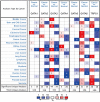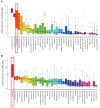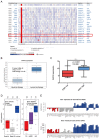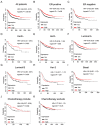GATA3 and TRPS1 are distinct biomarkers and prognostic factors in breast cancer: database mining for GATA family members in malignancies
- PMID: 28423734
- PMCID: PMC5471008
- DOI: 10.18632/oncotarget.16160
GATA3 and TRPS1 are distinct biomarkers and prognostic factors in breast cancer: database mining for GATA family members in malignancies
Abstract
GATA transcription factors are zinc finger DNA binding proteins that activate transcription during development and cell differentiation. To date, 7 members of GATA family have been reported. However, the expression patterns and the exact roles of distinct GATA family members contributing to tumorigenesis and progression of breast cancer (BC) remain to be elucidated. Here, we studied the expression of GATA transcripts in a variety of tumor types compared with the normal controls using the ONCOMINE and GOBO databases, along with their corresponding expression profiles in an array of cancer cell lines through CCLE analysis. Based on Kaplan-Meier plotter, we further investigated the prognostic values of GATA members specifically high expressed in BC patients. It was found that, when compared with normal tissues, GATA3 and TRPS1 were distinctly high expressed in BC patients among all GATA members. GATA3 expression was significantly associated with ESR1, while TRPS1 was correlated with ERBB2. In survival analysis, GATA3 and TRPS1 mRNA high expressions were correlated to better survival in BC patients, and TRPS1 high expression was significantly associated with longer RFS in patients who have received chemotherapy. These results suggest that GATA3 and TRPS1 are distinct biomarkers and essential prognostic factors for breast cancer.
Keywords: GATA; breast cancer; chemosensitivity; database mining; prognostic values.
Conflict of interest statement
The authors declare no conflicts of interest.
Figures







Similar articles
-
Coexpression of PBX1 and EMP2 as Prognostic Biomarkers in Estrogen Receptor-Negative Breast Cancer via Data Mining.J Comput Biol. 2020 Oct;27(10):1509-1518. doi: 10.1089/cmb.2019.0491. Epub 2020 Mar 27. J Comput Biol. 2020. PMID: 32216630
-
Clinical significance and biological function of transcriptional repressor GATA binding 1 in gastric cancer: a study based on data mining, RT-qPCR, immunochemistry, and vitro experiment.Cell Cycle. 2020 Nov;19(21):2866-2885. doi: 10.1080/15384101.2020.1827499. Epub 2020 Oct 12. Cell Cycle. 2020. PMID: 33044891 Free PMC article.
-
Diagnostic utility and sensitivities of matrix Gla protein (MGP), TRPS1 and GATA3 in breast cancer: focusing on metastatic breast cancer, invasive breast carcinoma with special features, and salivary gland-type tumours.Pathology. 2024 Jun;56(4):516-527. doi: 10.1016/j.pathol.2024.01.003. Epub 2024 Mar 14. Pathology. 2024. PMID: 38570266
-
[Roles of trichorhinophalangeal syndrome-1 gene in normal breast development and breast cancer].Zhongguo Yi Xue Ke Xue Yuan Xue Bao. 2013 Feb;35(1):121-4. doi: 10.3881/j.issn.1000-503X.2013.01.023. Zhongguo Yi Xue Ke Xue Yuan Xue Bao. 2013. PMID: 23469802 Review. Chinese.
-
Analysis of the function, mechanism and clinical application prospect of TRPS1, a new marker for breast cancer.Gene. 2025 Jan 10;932:148880. doi: 10.1016/j.gene.2024.148880. Epub 2024 Aug 23. Gene. 2025. PMID: 39181273 Review.
Cited by
-
CREBBP/EP300 acetyltransferase inhibition disrupts FOXA1-bound enhancers to inhibit the proliferation of ER+ breast cancer cells.PLoS One. 2022 Mar 30;17(3):e0262378. doi: 10.1371/journal.pone.0262378. eCollection 2022. PLoS One. 2022. PMID: 35353838 Free PMC article.
-
Mechanism of Telapristone Acetate (CDB4124) on Progesterone Receptor Action in Breast Cancer Cells.Endocrinology. 2018 Oct 1;159(10):3581-3595. doi: 10.1210/en.2018-00559. Endocrinology. 2018. PMID: 30203004 Free PMC article.
-
FoxM1 is a promising candidate target in the treatment of breast cancer.Oncotarget. 2017 Dec 12;9(1):842-852. doi: 10.18632/oncotarget.23182. eCollection 2018 Jan 2. Oncotarget. 2017. PMID: 29416660 Free PMC article.
-
Prognostic effects of the expression of inhibitor of DNA-binding family members on patients with lung adenocarcinoma.Oncol Lett. 2020 Nov;20(5):143. doi: 10.3892/ol.2020.12004. Epub 2020 Aug 21. Oncol Lett. 2020. PMID: 32934711 Free PMC article.
-
Knockdown of nucleophosmin 1 suppresses proliferation of triple-negative breast cancer cells through activating CDH1/Skp2/p27kip1 pathway.Cancer Manag Res. 2018 Dec 21;11:143-156. doi: 10.2147/CMAR.S191176. eCollection 2019. Cancer Manag Res. 2018. PMID: 30613163 Free PMC article.
References
-
- Ban KA, Godellas CV. Epidemiology of breast cancer. Surg Oncol Clin N Am. 2014;23:409–22. - PubMed
-
- Tao Z, Shi A, Lu C, Song T, Zhang Z, Zhao J. Breast Cancer: epidemiology and Etiology. Cell Biochem Biophys. 2015;72:333–8. - PubMed
-
- Simpson P. Introduction: notch signalling and choice of cell fates in development. Semin Cell Dev Biol. 1998;9:581–82. - PubMed
-
- Fortini ME. Introduction—Notch in development and disease. Semin Cell Dev Biol. 2012;23:419–20. - PubMed
MeSH terms
Substances
LinkOut - more resources
Full Text Sources
Other Literature Sources
Medical
Research Materials
Miscellaneous

